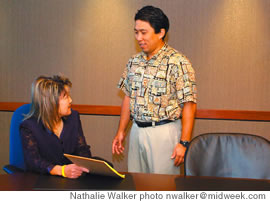Hurricane Insurance Costs

Hard at Work: Atlas Unit manager Lynne Shimizu and
VPO Lance Kawano discuss data on hurricane
insurance
The last time Hawaii experienced a major hurricane was in 1992 when Hurricane Iniki devastated Kauai and parts of Oahu. Since then, hurricane insurance premiums have steadily increased, leaving many homeowners wondering, “Are hurricane insurance providers making huge profits?”
The answer is no. Since 2001, despite having no hurricanes, at least five insurance companies in Hawaii have either completely or partially stopped writing hurricane insurance. These companies exited the market because current hurricane premiums do not adequately offset the expenses and the risk of writing hurricane insurance.
So why the high prices in hurricane insurance? Five of the costliest hurricanes in U.S. history have occurred on the mainland U.S., with three happening within the last two years. Although Hawaii homeowners do not pay for losses incurred from Mainland storms, these storms have an indirect impact on Hawaii homeowners through what is known as the Reinsurance Market.
Reinsurance means that for every $100 of hurricane premium collected, the insurance company pays another insurance company (a reinsurer) to share in the hurricane loss. The average reinsurance payout ranges between $50 and $90 for every $100 of premium collected. Reinsurers cover both Hawaii and mainland U.S. risks. Since the potential loss from a hurricane is so high, almost all hurricane insurers in Hawaii reinsure their hurricane insurance.
Reinsurers not only cover property in Hawaii, but also mainland U.S. property. Reinsurers have lost billions of dollars from mainland U.S. storms resulting in less money for mainland U.S. and Hawaii programs. And, as you know, less supply without a decrease in demand means higher prices.
In addition, the larger than expected losses from the recent Mainland storms have made many of the hurricane forecasters increase their storm damage loss estimates. Thus, the loss estimate when a large hurricane makes landfall on Oahu has probably increased by an estimated 10 to 20 percent. Larger forecasted losses means reinsurers and ultimately Hawaii’s hurricane insurers must increase prices. Paul Knutson, managing director for Guy Carpenter & Company Inc. (a leading global reinsurance specialist), said, “The last few years have been extremely challenging for purchasers of reinsurance. The recent mainland U.S. hurricane experience has forced reinsurers to increase their forecasted storm damage loss estimates. As a result, Hawaii’s purchasers of reinsurance might be experiencing significant rate increases.”
Hurricane insurance is an important, complex and rapidly changing field. Fortunately, Hawaii has an industry full of well-trained insurance professionals to guide homeowners through the process. These professionals are not only required to complete numerous hours of classroom instruction in order to maintain their license, but many insurance agents also educate themselves on industry changes by attending classes from respected organizations such as Chartered Property Casualty Underwriters (CPCU) and Certified Insurance Counselors (CIC).
Concerned homeowners should contact an insurance professional to learn more about the hurricane insurance process. These professionals can help to evaluate each client’s unique situation and develop options that best fit his or her needs.
Next Week: Dr. Attilio Aveno, Managing Member/Founder of Foot and Ankle Inkle Institute of Hawaii
E-mail this story | Print this page | Comments (0) | Archive | RSS Comments (0) |
Most Recent Comment(s):




 Del.icio.us
Del.icio.us








